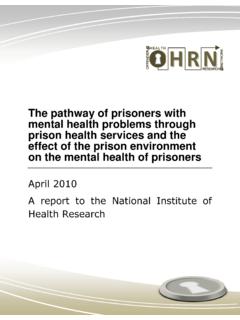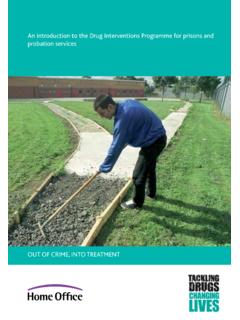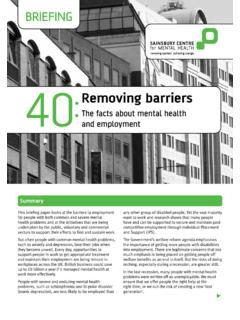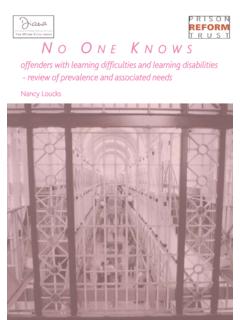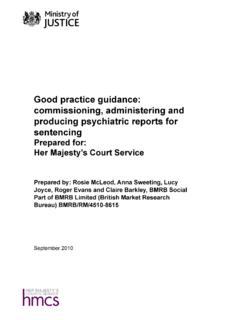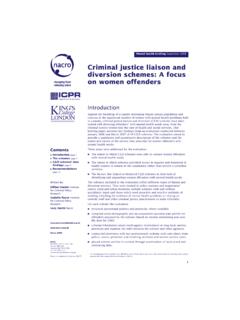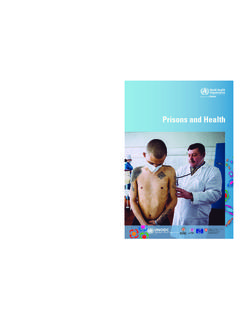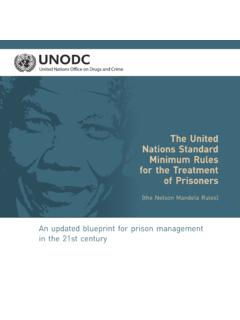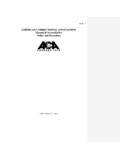Transcription of Review of Drug and Alcohol Treatments in Prison and ...
1 Review of Drug and Alcohol Treatments in Prison and Community Settings A Systematic Review Conducted on Behalf of the Prison health Research Network Amanda J Roberts, Adrian J Hayes, Julie Carlisle & Jenny Shaw The University of Manchester November 2007 This project was commissioned and funded by Offender health in the Department of health , via the Prison health Research Network. Thanks to Maria Leitner, Wally Barr, Nat Wright, Mike Farrell, Charlie Brooker, David Marteau and Jane Senior for invaluable assistance during the writing of this report. 1 TABLE OF CONTENTS EXECUTIVE SUMMARY ..3 SECTION 1: Review OF CURRENT POLICY AND GUIDANCE ..18 Prison AND 27 SECTION 2: Review OF DRUG Review OF OFFENDER Fazel et al (2006)..34 Perry et al (2006)..38 Holloway et al (2005)..44 Review OF COMMUNITY Opioid Abuse and Cocaine Abuse and Amphetamine and amphetamine type stimulants (ATS) abuse and Cannabis Abuse and Iatrogenic use of prescribed 74 SECTION 3: Review OF Alcohol Review OF OFFENDER Narrative Summary Conclusions by Treatment Summary Conclusions by Study Review OF COMMUNITY Pharmacological Psychosocial Preventative SECTION 4: APPENDIX 1: ACCREDITED OFFENDING BEHAVIOUR PROGRAMMES RELATING TO SUBSTANCE APPENDIX 2: EFFECTIVENESS OF Treatments INCLUDED IN THE 24 RCTS IN PERRY ET AL (2006) BY TYPE OF INTERVENTION.
2 139 APPENDIX 3: EFFECTIVENESS OF Treatments INCLUDED IN THE STUDIES REPORTED IN HOLLOWAY ET AL (2005) BY TYPE OF APPENDIX 4: RESULTS OF META-ANALYSIS OF POST-TEST ONLY STUDIES INCLUDED IN HOLLOWAY ET AL APPENDIX 5: RESULTS OF META-ANALYSIS OF PRE-POST TEST ONLY STUDIES WITH CONTROLS INCLUDED IN HOLLOWAY ET AL APPENDIX 6: RESULTS OF TREATMENT EFFECTIVENESS OF INCLUDED STUDIES CATEGORISED BY TYPE OF 154 APPENDIX 7: GENDER OF PARTICIPANTS IN THE INCLUDED APPENDIX 8: REFERENCES OF EXCLUDED STUDIES FROM THE Alcohol Review WITH REASONS FOR EXCLUSION..160 2 Executive Summary Rationale Substance misuse is a major problem in the general population as well as in prisons and the wider Criminal Justice System (CJS). Whilst there is a large body of evidence for community-based drug Treatments , there has been far less research in criminal justice settings. We outline the recent in-depth reviews of offender-based drug Treatments . Within the field of substance misuse, Alcohol is not often considered separately.
3 We have therefore conducted a new systematic Review of Alcohol Treatments in offender populations. In both areas, we have also considered the evidence for community-based treatment interventions and highlighted gaps in relevant Prison research. Section 1: Background There are several policy documents and strategies for the management and treatment of problematic substance users in offender populations. The National Offender Management Service (NOMS) has a strategy relating to problematic drug users in correctional services (NOMS, 2005). HM Prison Service have in place drug and Alcohol strategies (HMPS, 2002; HMPS 2003; HMPS, 2006), as well as a good practice guide for Alcohol treatment and interventions (HMPS, 2004). The National Probation Service also has a strategy for working with Alcohol misusing offenders (National Probation Service, 2006). Finally, the cross-Government document Safe.
4 Sensible. Social (2007), updating the national Alcohol strategy, contains specific recommendations for offender populations. Section 2: Review of Drug Treatments This section begins with a summary of three systematic reviews specifically relating to substance misuse in offender settings. These recent and comprehensive reviews have been critically appraised in this section with their conclusions described at some length. Following this, there is a summary of 3 the evidence for Treatments in community settings, with potential gaps for offender-based research highlighted. Review of Offender Treatments Three systematic reviews of substance misuse and dependence in Prison and/or offender populations have been published in the last three years. Fazel et al (2006) aimed to determine the prevalence of substance abuse/dependence in prisons, and to compare this with the general population.
5 Perry et al (2006) aimed to establish the effect of offender Treatments on continued drug use and reoffending, in a variety of settings including courts, secure care, and in the community. Finally, Holloway et al (2005) examined the effect of criminal justice and drug programmes on drug-related crime. Fazel et al (2006) The basis for this Review was to explore the relationship between offending behaviours and substance abuse in various criminal and medical settings. Fazel et al (2006) suggested that a greater understanding of the extent of substance abuse and dependence in offenders would aid the development of appropriate services and inform treatment interventions. Therefore, a systematic Review was conducted to ascertain the prevalence rates of substance abuse/dependence in prisoners and to compare prevalence rates with that of the general population. Overall, it was concluded that the prevalence estimates of drug/ Alcohol abuse/dependence for prisoners is higher than in the general population.
6 North American figures revealed that male prisoners had slightly higher (but not significant) rates of Alcohol dependency while drug dependency was 2 to 10 times higher than the general population. For female prisoners, differences were more marked: Alcohol dependency was 2 to 10 times higher and drug dependency up to 13 times higher than that of females in the general population. Fazel et al (2006) therefore suggested that service provision for female prisoners should be a priority. However, further research into the 4 prevalence of Alcohol abuse/dependence in females outside the US is needed before adequate recommendations can be made for the provision of treatment services. Perry et al (2006) The research question in this Review explored whether; (i) court based interventions, (ii) secure establishment-based interventions, and (iii) community-based interventions for drug misusing offenders reduce drug use and/or criminal activity?
7 Therapeutic communities and aftercare seemed to be the most promising of interventions. However, the studies that reported these findings were quasi-experimental and may have included some bias: More robust designs are needed to elucidate these results. Given the methodological weaknesses of the studies, very limited conclusions on treatment success can be drawn from this Review . It is apparent, however, that there is no single gold standard treatment intervention. Furthermore, limited conclusions can be drawn as to the cost effectiveness of treatment interventions for drug misusing offenders with only one study including economic evaluations. Therefore, Perry et al (2006) suggested a need to conduct better quality research that utilises standardised outcome measures which will enable comparisons to be made across literature. Holloway et al (2005) In direct response to the proposals made in the Updated Drug Strategy 2002 (Home Office 2002), Holloway et al (2005) systematically reviewed the literature on the effectiveness of (i) criminal justice programmes that aim to directly reduce drug related crime, or (ii) drug treatment programmes that as a consequence may indirectly serve to reduce drug related crime.
8 Four major conclusions can be drawn. Firstly, most drug interventions seemed to work in reducing drug related crime. Meta-analyses showed all programmes to be effective. Forty-four of the 5 52 studies in the quantitative narrative Review found the programme under study was effective in reducing drug related crime on at least one measure. Secondly, methadone treatment, heroin treatment, therapeutic communities, psychosocial approaches, drug courts and probation and parole supervision seemed to be more effective than supervision and aftercare, drug testing, and other criminal justice approaches. Holloway et al (2005) suggested that some findings are based on a small number of studies with small sample sizes and therefore findings should be treated with caution. It is also important to be aware that some programmes work for some offenders and not others. Thirdly, it seemed that programme outcome is related to demographic characteristics of the individual.
9 In order for results to be more informative studies would need to be conducted that directly investigate the interaction between the treatment programme and individuals demographic characteristics. However, the Review demonstrated that many programmes were more effective for males than females and that younger people were more responsive to the treatment interventions than older people. The latter finding highlights a possible need for early intervention for drug treatment programmes in order to potentially prevent later recidivism. The final conclusion that can be drawn from the Review relates to programme intensity. The meta-analyses showed that higher intensity programmes were 50% more likely to reduce criminal behaviour than their low intensity equivalents. The quantitative narrative Review showed that for 4 out of 11 studies evaluating methadone Treatments , those administering higher continuous injected dosages showed greater reductions in offending and, when coupled with maximum supervision and aftercare following the drug treatment programme, reduced crime by 90% as opposed to 57% among the group who received minimum aftercare.
10 Holloway et al (2005) stressed the need for good quality research to be conducted on the effectiveness of treatment programmes for drug-misusing offenders in the UK. Additionally the authors appealed to researchers to 6 investigate the causal mechanisms via the construction of possible theoretical reasons for the effectiveness of treatment programmes in reducing later criminal activity. Herein lies an opportunity for more qualitative and longitudinal research to follow offenders progress as they are receiving treatment interventions from a user perspective. Holloway et al (2005) suggested that government policy is not prescriptive enough in its promotion of the specific interventions needed in order to tackle drug misuse and subsequently achieve the objectives set out in the Updated Drugs Strategy 2002 (Drugs Strategy Directorate, 2002). They suggested that prioritising the treatment interventions shown to be effective would be fruitful in achieving this objective.
